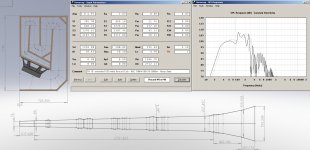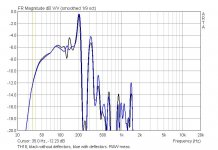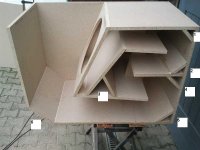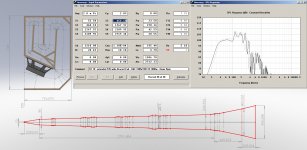Reducing the mouth also has a negative effect on the directivity of the horn. Roughly, down to 1/3WL the horn works similar to traditional horns (with reduced mouth size) in their directivity response. Below that point TH's tend to loose their efficiency and directivity. You can see how that works if you measure impulse response (frequency related). Below 1/3 you see the direct signal from the driver becomes more important. This is why the TH doesn't drop its LF content as much like a traditional horn. But the downside is that below 1/3WL the TH starts to work more in a omni-pattern. In single use that doesn't matter as the audience will be nearby the sub, but in stacks for larger events it is important to keep the directivity in mind, I think. That's why our 18" TH's have a little higher roll off (bigger mouth) in favour for better coupling/directivity in stacks.The bandwidth can be increased by reducing the mouth size considerably, but as said you loose the efficiency.
Last edited:
Would it be possible to make the box higher, say 114cm (45" lab size) to gain some extra pathlength and lower the response? I'm taking the cab apart tomorrow and removing the reflectors just so see if that makes any difference in lowering the response.
Basically we are looking in some possible replacements for the lab subs. We are really pleased with the labs output and SQ, but if there is a chance that something smaller and lighter would have a similar output then it's worth exploring it
Basically we are looking in some possible replacements for the lab subs. We are really pleased with the labs output and SQ, but if there is a chance that something smaller and lighter would have a similar output then it's worth exploring it
Last edited:
Hi SG3525
It is certainly possible to stretch this the fold in order to gain some path length but if you would like the results is debatable
I have taken an early version without the extra reflectors, and stretched it to 1140 high. I also have straightened out the bulge in the path at the first bend by increasing S1. This makes the Hornresp sim look slightly worse at the 100hz dip but is not so significant when you model the entire path in Akabak.
I have done a comparative sim, using your test driver, with a tweaked LE value that gives a best match to your measured data.
The original box as you built is the grey line in the SPL response window.
If it is worthwhile, I could supply you with some more dimensions to prototype a cabinet.
I look forward to seeing the results of removing some of the reflectors
PS its going to need a bit more work but this should give a reasonable expectation of the differences!
Regards
Martin
It is certainly possible to stretch this the fold in order to gain some path length but if you would like the results is debatable
I have taken an early version without the extra reflectors, and stretched it to 1140 high. I also have straightened out the bulge in the path at the first bend by increasing S1. This makes the Hornresp sim look slightly worse at the 100hz dip but is not so significant when you model the entire path in Akabak.
I have done a comparative sim, using your test driver, with a tweaked LE value that gives a best match to your measured data.
The original box as you built is the grey line in the SPL response window.
If it is worthwhile, I could supply you with some more dimensions to prototype a cabinet.
I look forward to seeing the results of removing some of the reflectors
PS its going to need a bit more work but this should give a reasonable expectation of the differences!
Regards
Martin
Attachments
Last edited:
Hi XoC1, thanks for the sims. Yes the higher efficiency of the original does look better  Below are the comparison measurements of the original TH with deflectors (blue) and the one without (black). The only noticeable difference seems to be in the 45 to 65Hz range. All measurements are RAW.
Below are the comparison measurements of the original TH with deflectors (blue) and the one without (black). The only noticeable difference seems to be in the 45 to 65Hz range. All measurements are RAW.
Currently the next thing is to wait for the 4 Ohm 18SW115 to come and then some more testing to see if the added power and 5mm of Xmax do any difference
Currently the next thing is to wait for the 4 Ohm 18SW115 to come and then some more testing to see if the added power and 5mm of Xmax do any difference
Attachments
Hi Sg3625
Thanks for the measurement plot.
There seems to be a trade off between more LF energy without the reflectors, and a smoother extended HF with the reflectors.
When you say you removed the reflectors, which ones did you remove?
I have put some numbers on one of your construction photos for reference.
Regards
Martin
Thanks for the measurement plot.
There seems to be a trade off between more LF energy without the reflectors, and a smoother extended HF with the reflectors.
When you say you removed the reflectors, which ones did you remove?
I have put some numbers on one of your construction photos for reference.
Regards
Martin
Attachments
I have reworked the 'extended' concept for the TH18.
I am fairly confident that the horn taper on this folding is accurate and linear.
Target error tolerance is < 0.1mm
I added a extra panel to the horn throat in the same way that Josh Ricci has used it in the Othorn & Gjallerhorn. This seems to reduce the 100Hz dip in the response.
Adjusting the S2 dimension in this fold as suggested by epa is not easy. The way the horn width dimensions stack up, effects the front to back depth of the cabinet. If anything the response looked flatter with a smaller S2 dimension when adjusting in the Hornresp Wizard, but that is not practical with this folding.
Screenshot shows latest attempt. Original cabinet response in grey.
I am fairly confident that the horn taper on this folding is accurate and linear.
Target error tolerance is < 0.1mm
I added a extra panel to the horn throat in the same way that Josh Ricci has used it in the Othorn & Gjallerhorn. This seems to reduce the 100Hz dip in the response.
Adjusting the S2 dimension in this fold as suggested by epa is not easy. The way the horn width dimensions stack up, effects the front to back depth of the cabinet. If anything the response looked flatter with a smaller S2 dimension when adjusting in the Hornresp Wizard, but that is not practical with this folding.
Screenshot shows latest attempt. Original cabinet response in grey.
Attachments
[QUOTEI added a extra panel to the horn throat in the same way that Josh Ricci has used it in the Othorn & Gjallerhorn. This seems to reduce the 100Hz dip in the response.
][/QUOTE]
Looking at the graph, I dont see less of a dip at 100Hz? I see more of a dip.
Am I missing something?
Andy
][/QUOTE]
Looking at the graph, I dont see less of a dip at 100Hz? I see more of a dip.
Am I missing something?
Andy
Thanks I see it now."Seems to reduce the 100Hz dip in the response" compared to his previous extended concept TH18 in post #323.
The NW100 was just for testing and it's currently the only 18" sub I could get to test the TH18  If I remember correctly the SW115 goes a little bit lower according to the sims.
If I remember correctly the SW115 goes a little bit lower according to the sims.
1,2 and 4 are the only ones removed.When you say you removed the reflectors, which ones did you remove?
Martin
Last edited:
From what I've picked up in other threads, it can be ~night and day from your as-built proto to a finished, measured design. Others have shown measured improvement from using shallower angles(better HF response) on the corner braces and bracing the panels with no more than 8" of unsupported span in any direction. This would only add minimal complication and material to the finished product for the potential improvement. After you finalize the design, you will also see an improvement from construction with proper material.
That's what I was thinking...could the poor measured response of the cabinet in the <50hz range be due to poor cabinet material/construction?
If the reflectors were removed with ease, it makes me think that the cabinet was not constructed well (securely glued/screwed together) along with crappy material..which could severely effect output, correct?
If the reflectors were removed with ease, it makes me think that the cabinet was not constructed well (securely glued/screwed together) along with crappy material..which could severely effect output, correct?
That's what I was thinking...could the poor measured response of the cabinet in the <50hz range be due to poor cabinet material/construction?
If the reflectors were removed with ease, it makes me think that the cabinet was not constructed well (securely glued/screwed together) along with crappy material..which could severely effect output, correct?
An impedance response measurement can by used to determine if the cabinet is causing any 'issues'. See the following link for example:
The Subwoofer DIY Page v1.1 - Projects : Using Impedance Graphs
very useful .An impedance response measurement can by used to determine if the cabinet is causing any 'issues'. See the following link for example:
The Subwoofer DIY Page v1.1 - Projects : Using Impedance Graphs
tnx
- Home
- Loudspeakers
- Subwoofers
- TH-18 Flat to 35hz! (Xoc1's design)



